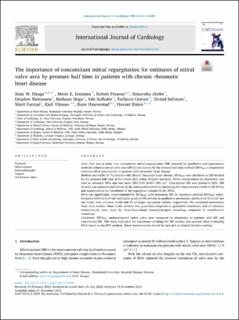| dc.contributor.author | Hauge, Ståle Wågen | |
| dc.contributor.author | Estensen, Mette-Elise | |
| dc.contributor.author | Persson, Robert | |
| dc.contributor.author | Abebe, Sintayehu | |
| dc.contributor.author | Mekonnen, Desalew | |
| dc.contributor.author | Nega, Berhanu | |
| dc.contributor.author | Solholm, Atle | |
| dc.contributor.author | Graven, Torbjørn | |
| dc.contributor.author | Salvesen, Øyvind Olav | |
| dc.contributor.author | Farstad, Marit | |
| dc.contributor.author | Vikenes, Kjell | |
| dc.contributor.author | Haaverstad, Rune | |
| dc.contributor.author | Dalen, Håvard | |
| dc.date.accessioned | 2024-02-29T09:18:23Z | |
| dc.date.available | 2024-02-29T09:18:23Z | |
| dc.date.created | 2023-12-18T12:49:56Z | |
| dc.date.issued | 2023 | |
| dc.identifier.citation | International Journal of Cardiology. 2023, 398 (131600), . | en_US |
| dc.identifier.issn | 0167-5273 | |
| dc.identifier.uri | https://hdl.handle.net/11250/3120426 | |
| dc.description.abstract | Aims
Aim was to study how concomitant mitral regurgitation (MR) assessed by qualitative and quantitative methods influence mitral valve area (MVA) calculations by the pressure half time method (MVAPHT) compared to reference MVA (planimetry) in patients with rheumatic heart disease.
Methods and results
In 72 patients with chronic rheumatic heart disease, MVAPHT was calculated as 220 divided by the pressure half time of the mitral early inflow Doppler spectrum. Direct measurement by planimetry was used as reference MVA and was mean (SD) 0.99 (0.69–1.99) cm2. Concomitant MR was present in 82%. MR severity was assessed qualitatively in all, semi-quantitatively by measuring the vena contracta width in 58 (81%), and quantitatively by calculation of the regurgitant volume in 28 (39%).
MVA was significantly underestimated by MVAPHT, with increasing MR. In regression analyses MVAPHT underestimated MVA by 0.19 cm2 per higher grade of MR severity in qualitative assessment, and by 0.12–0.13 cm2 per mm larger vena contracta width and 10 ml larger regurgitant volume, respectively. The presented associations were more evident when i) MR severity was quantified compared to qualitative assessment and ii) reference measurements were made by three-dimensional transoesophageal recordings compared to transthoracic recordings.
Conclusion
MVAPHT underestimated mitral valve area compared to planimetry in patients with MS and concomitant MR. This study highlights the importance of taking the MR severity into account when evaluating MVA based on the PHT method. Direct measurements should be included in clinical decision making. | en_US |
| dc.language.iso | eng | en_US |
| dc.publisher | Elsevier | en_US |
| dc.rights | Navngivelse 4.0 Internasjonal | * |
| dc.rights.uri | http://creativecommons.org/licenses/by/4.0/deed.no | * |
| dc.title | The importance of concomitant mitral regurgitation for estimates of mitral valve area by pressure half time in patients with chronic rheumatic heart disease | en_US |
| dc.title.alternative | The importance of concomitant mitral regurgitation for estimates of mitral valve area by pressure half time in patients with chronic rheumatic heart disease | en_US |
| dc.type | Peer reviewed | en_US |
| dc.type | Journal article | en_US |
| dc.description.version | publishedVersion | en_US |
| dc.source.pagenumber | 0 | en_US |
| dc.source.volume | 398 | en_US |
| dc.source.journal | International Journal of Cardiology | en_US |
| dc.source.issue | 131600 | en_US |
| dc.identifier.doi | 10.1016/j.ijcard.2023.131600 | |
| dc.identifier.cristin | 2214837 | |
| cristin.ispublished | true | |
| cristin.fulltext | original | |
| cristin.qualitycode | 1 | |

